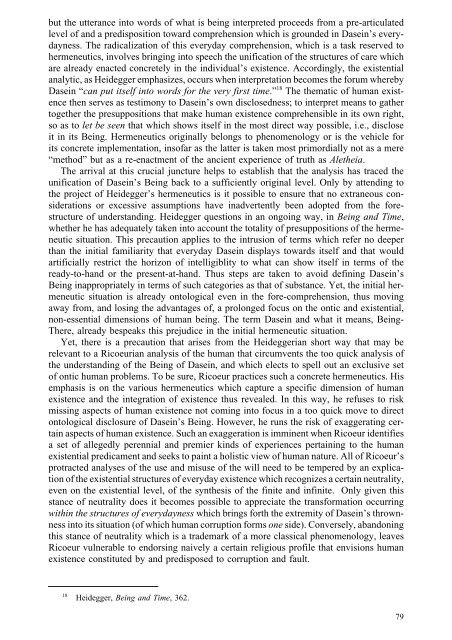[Andrzej_Wiercinski_(ed ... - WordPress.com
[Andrzej_Wiercinski_(ed ... - WordPress.com
[Andrzej_Wiercinski_(ed ... - WordPress.com
Create successful ePaper yourself
Turn your PDF publications into a flip-book with our unique Google optimized e-Paper software.
ut the utterance into words of what is being interpret<strong>ed</strong> proce<strong>ed</strong>s from a pre-articulat<strong>ed</strong>level of and a pr<strong>ed</strong>isposition toward <strong>com</strong>prehension which is ground<strong>ed</strong> in Dasein’s everydayness.The radicalization of this everyday <strong>com</strong>prehension, which is a task reserv<strong>ed</strong> tohermeneutics, involves bringing into speech the unification of the structures of care whichare already enact<strong>ed</strong> concretely in the individual’s existence. Accordingly, the existentialanalytic, as Heidegger emphasizes, occurs when interpretation be<strong>com</strong>es the forum wherebyDasein “can put itself into words for the very first time.” 18 The thematic of human existencethen serves as testimony to Dasein’s own disclos<strong>ed</strong>ness; to interpret means to gathertogether the presuppositions that make human existence <strong>com</strong>prehensible in its own right,so as to let be seen that which shows itself in the most direct way possible, i.e., discloseit in its Being. Hermeneutics originally belongs to phenomenology or is the vehicle forits concrete implementation, insofar as the latter is taken most primordially not as a mere“method” but as a re-enactment of the ancient experience of truth as Aletheia.The arrival at this crucial juncture helps to establish that the analysis has trac<strong>ed</strong> theunification of Dasein’s Being back to a sufficiently original level. Only by attending tothe project of Heidegger’s hermeneutics is it possible to ensure that no extraneous considerationsor excessive assumptions have inadvertently been adopt<strong>ed</strong> from the forestructureof understanding. Heidegger questions in an ongoing way, in Being and Time,whether he has adequately taken into account the totality of presuppositions of the hermeneuticsituation. This precaution applies to the intrusion of terms which refer no deeperthan the initial familiarity that everyday Dasein displays towards itself and that wouldartificially restrict the horizon of intelligiblity to what can show itself in terms of theready-to-hand or the present-at-hand. Thus steps are taken to avoid defining Dasein’sBeing inappropriately in terms of such categories as that of substance. Yet, the initial hermeneuticsituation is already ontological even in the fore-<strong>com</strong>prehension, thus movingaway from, and losing the advantages of, a prolong<strong>ed</strong> focus on the ontic and existential,non-essential dimensions of human being. The term Dasein and what it means, Being-There, already bespeaks this prejudice in the initial hermeneutic situation.Yet, there is a precaution that arises from the Heideggerian short way that may berelevant to a Ricoeurian analysis of the human that circumvents the too quick analysis ofthe understanding of the Being of Dasein, and which elects to spell out an exclusive setof ontic human problems. To be sure, Ricoeur practices such a concrete hermeneutics. Hisemphasis is on the various hermeneutics which capture a specific dimension of humanexistence and the integration of existence thus reveal<strong>ed</strong>. In this way, he refuses to riskmissing aspects of human existence not <strong>com</strong>ing into focus in a too quick move to directontological disclosure of Dasein’s Being. However, he runs the risk of exaggerating certainaspects of human existence. Such an exaggeration is imminent when Ricoeur identifiesa set of alleg<strong>ed</strong>ly perennial and premier kinds of experiences pertaining to the humanexistential pr<strong>ed</strong>icament and seeks to paint a holistic view of human nature. All of Ricoeur’sprotract<strong>ed</strong> analyses of the use and misuse of the will ne<strong>ed</strong> to be temper<strong>ed</strong> by an explicationof the existential structures of everyday existence which recognizes a certain neutrality,even on the existential level, of the synthesis of the finite and infinite. Only given thisstance of neutrality does it be<strong>com</strong>es possible to appreciate the transformation occurringwithin the structures of everydayness which brings forth the extremity of Dasein’s thrownnessinto its situation (of which human corruption forms one side). Conversely, abandoningthis stance of neutrality which is a trademark of a more classical phenomenology, leavesRicoeur vulnerable to endorsing naively a certain religious profile that envisions humanexistence constitut<strong>ed</strong> by and pr<strong>ed</strong>ispos<strong>ed</strong> to corruption and fault.18Heidegger, Being and Time, 362.79


